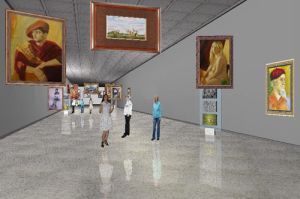special EAEA
 |
|
 |
ARCHITECTURE AND MODERN INFORMATION TECHNOLOGIES
МЕЖДУНАРОДНЫЙ ЭЛЕКТРОННЫЙ НАУЧНО-ОБРАЗОВАТЕЛЬНЫЙ ЖУРНАЛ ПО НАУЧНО-ТЕХНИЧЕСКИМ И УЧЕБНО-МЕТОДИЧЕСКИМ АСПЕКТАМ СОВРЕМЕННОГО АРХИТЕКТУРНОГО ОБРАЗОВАНИЯ И ПРОЕКТИРОВАНИЯ С ИСПОЛЬЗОВАНИЕМ ВИДЕО И КОМПЬЮТЕРНЫХ ТЕХНОЛОГИЙ
DESIGNING EXPERIENCE IN VIRTUAL WORLDS.Theses
Rivka Oxman, Rina Kolomisky
Faculty of Architecture, Technion, Israel Institute of Technology
Keywords: virtual environments, psychology - sense of presence - sense of place; scenario-based; media interactivity; methods and techniques of spatial simulation
The immense growth in computer and virtual reality technology has resulted in the development of new approaches to the design of virtual environments. Virtual environments related to everyday life are currently being designed and implemented to accommodate diverse functions. These information environments are generally not sufficient to simulate the experience of real life. There is a need to establish new conceptual approaches to enhance the richness of our experience in virtual world.
Current definitions of Virtual Environments are related to their performance as digital spaces. Virtual Environments are defined as computer programs that implement digital worlds with their own “physical” and “biological” laws” (Heudin, 1998); environment that contains objects and an interface linking the user and the environment (Sikora, Steinberg and Lattaud, 2000); a collection of objects, each object corresponding to things, space, and people (Gu, and Maher, 2002); However these definitions do not contribute to the conceptual understanding of such environments.
The aim of this research is to formulate a new concept for designing virtual worlds which is based three theoretical concepts: sense of presence, sense of place and scenarios. Scientists in the field of psychology have developed the theory of a sense of presence (Steuer, 1992; IJsselsteijn and Riva, 2003, Slater and Steed 2000). According to them, the main feature of designing virtual environments is the sense of place, which contributes to the sense of presence. The concept of scenario comes from the fields of theater, movies, computer games, animation etc. Fig. 1, Fig. 2 illustrates an example of a meeting of a visitor who invites the painter on his request to join him.
 |
 | |
|
Fig. 1 |
Fig. 2 |
We present a new methodology which is based on scenario design. We propose that scenario based approach contributes to the sense of presence and sense of place. It is based on the exploration of desired linked realistic places in a given scenario. (see figure). The implementation is based on the interactive content of the virtual architectural environment which links desired locations according to a certain scenario at any moment. Our approach to scenario-based design attempts to utilize the concepts of “content” and “form” in a situation of co-presence. This is created by the integration and the interaction of the two types of presence, physical presence (form) and the social presence (content). Scenario-based design creates choice and opportunities for social interaction simultaneously in various virtual places. The following software tools were used: Cortona VRML Client for playing VRML files, 3D studio VIZ, for some modeling, and Notepad for some editing of *.wrl files.
















